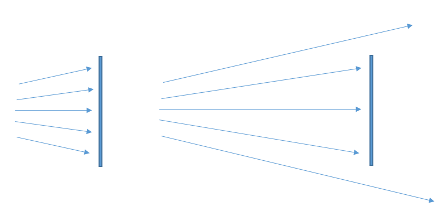Hey guys. I'm just having a bit of trouble understanding how fringe spacing can be increased/decreased. How does increasing the wavelength and distance to the screen increase the spacing and reducing the slits increase it? I just can't seem to get my head around how it happens.
Also i don't understand the paragraph on Extent of diffraction from my book. It says that the extent of diffraction  wavelength / size of slit =
wavelength / size of slit =  . What does this mean exactly?
. What does this mean exactly?
One more question that I didn't understand: When white light is passed through double slits, colored fringes can be observed. What is responsible for this phenomenon?
These are the ways I like to think about it. May or may not be truly accurate but it worked for me.

Wavelength: Imagine an 800nm wave of light and a 300nm wave of light. If they are both trying to fit through a slit which is 400nm, which one is going to have more trouble getting through the gap? The 800nm will have much more trouble, and therefore will experience greater diffraction which will spread out the band spacing.
Distance: This one is trickier to understand. Have a look at this diagram here:

If you imagine one arrow being a maximum (bright fringe), moving the rectangle further back will result in only 3 of the fringes appearing on the rectangle, so they will spread apart compared to 5 fringes over the same area when the rectangle is much closer.
Reducing Slit: Well, it's the same as the wavelength scenario, but instead of different wavelengths changing, its different slit sizes. If we have light of 500nm wave length, is it going to have an easier time passing through a gap which is 600nm or 400nm? The smaller the slit size, the more impedence it will have with the slit and more diffraction will occur.
Extent of Diffraction: They're taking the ratio of wavelength over slit size. If the wavelength and the slit size are exactly the same, the fraction will equal 1. If the wavelength is bigger than the size of the slit, the fraction will be > 1 and if the wavelength is smaller than the slit the fraction will be < 1. You can use this to get a rough idea as to the extent of the diffraction.
White Light: White light is made up of light of many different wavelengths. When it passes through the slits, the different wavelengths that make up the white light will be diffracted to different degrees, which will cause the red light to spread differently from the green light, which leads to colored fringes.

